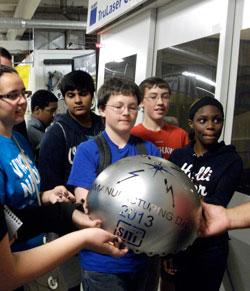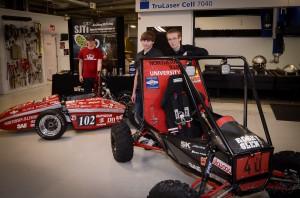- FMA
- The Fabricator
- FABTECH
- Canadian Metalworking
Categories
- Additive Manufacturing
- Aluminum Welding
- Arc Welding
- Assembly and Joining
- Automation and Robotics
- Bending and Forming
- Consumables
- Cutting and Weld Prep
- Electric Vehicles
- En Español
- Finishing
- Hydroforming
- Laser Cutting
- Laser Welding
- Machining
- Manufacturing Software
- Materials Handling
- Metals/Materials
- Oxyfuel Cutting
- Plasma Cutting
- Power Tools
- Punching and Other Holemaking
- Roll Forming
- Safety
- Sawing
- Shearing
- Shop Management
- Testing and Measuring
- Tube and Pipe Fabrication
- Tube and Pipe Production
- Waterjet Cutting
Industry Directory
Webcasts
Podcasts
FAB 40
Advertise
Subscribe
Account Login
Search
Celebrating Manufacturing Day
- By Eric Lundin
- October 9, 2013

Superior Joining Technologies Inc., Machesney Park, Ill., opened its doors to area high-school students on Oct. 4, Manufacturing Day. The company used its 3-D laser cutting machine, a TRUMPF TruLaser 7040, to make a commemorative steel dome.
The many John Q. Publics who think that manufacturing in the U.S. is dying—or worse, who think it’s already dead—got a chance to see what they’ve been missing on Oct. 4, when more than 800 manufacturers throughout the U.S. opened their doors for tours. The main goal of Manufacturing Day is straightforward: to educate those outside manufacturing about the industry. Removing the stigma it has falsely earned is the first step in getting high-school students to consider careers in manufacturing; at the same time, helping elected officials understand manufacturing helps in drawing attention to regulations, taxes, and zoning issues that plague manufacturers.
While the U.S. manufacturing industry doesn’t employ the numbers of people it once did, it’s still a viable force. Manufacturing in the U.S. is nimbler, more technologically advanced, and more productive than ever before, and by some estimates, it contributes nearly 40 percent of the world’s total manufactured output.
Fast Cars and Competing RobotsSuperior Joining Technologies Inc., Machesney Park, Ill., a specialty welding shop that focuses on the aerospace industry, hosted a tour that demonstrated laser cutting and laser etching, and familiarized the students with welding and nondestructive testing. Although the unemployment rate in the U.S. is still more than 7 percent, Superior has been growing and hiring.
“We’ve added two welding areas this year, growing from three to five,” said Teresa Beach-Shelow, president and owner of the company. Superior Joining also has added machining to its repertoire of services, which includes gas tungsten arc welding (GTAW), microwelding, laser welding, silver brazing, multiaxis laser cutting and welding. “We also have added a machining center,” Beach-Shelow said, adding that it is the company’s first foray into machining.
In addition to showing students its laser-etching capability and demonstrating cutting on its TruLaser 7040, a TRUMPF product, Superior showed visitors several completed fabrication projects that it had a hand in—two racing cars and one robot. The cars were a Baja SAE series car and a Formula SAE® series car, designed and built by two teams of engineering students from Northern Illinois University, DeKalb, Ill..
“It accelerates from zero to 60 in 3.8 seconds and has a top speed around 75 miles per hour,” said Tim Brown, a mechanical engineering student in his senior year who participated in designing and building the Formula car. Much more than a go-kart, but not quite a full-blown racing car, an SAE series car provides the teams real-world experience in a variety of fields—mechanical, electrical, and electronic.
“Speed is half the criteria,” Brown said. “Design is the other half.” Although the students do quite a bit of the fabrication work, the chassis is assembled by a company with welding expertise—in this case, Superior Joining Technologies.
Visitors also got to see Frisbee® discs launched by a robot developed by Rockford Robotics, a team of high-school students.
“The teams have just six weeks to build the robot,” said Eli Ball, a Rockford Robotics team captain who has been involved since 2010. The team used quite a bit of the knowledge it developed in last year’s competition, in which the robots launched foam basketballs.
“We used an autotracking system on that robot,” Ball said. One of the team members would drive the robot by remote control, and the robot did the rest. It was set up with a 360-degree shooting capability, meaning it could shoot from any angle.

Northern Illinois University fields two cars for the SAE Collegiate Design Series, a Formula car (left) and a Baja car (right). While students do all of the design work and much of the fabrication, companies such as Superior Joining Technologies also contribute to these projects. Photo courtesy of Brad Henry.
“We would drive the robot to a position about 15 feet from the basket, and the robot would determine the distance, angle, and motor speed for the shot.” Ball estimated that the robot sunk about 90 percent of the basketballs it launched. The robot was a quarterfinalist, taking third place in a field of 48 teams.
The Frisbee-launching robot took first place in RoboFest, a competition held in Milwaukee, Wis., on Sept. 28.
Organized by For Inspiration and Recognition of Science and Technology (FIRST), the competition is intended to foster much more than the ability to design robots, Ball said.
“It’s not just developing engineers, but leaders,” he said. “It’s not just a question of whether your team is succeeding, but whether everyone is succeeding.” To this end, the robot competitions often consist of two teams of robots, fostering a high level of cooperation. Team members also move from one team to another, spreading the accumulated knowledge.
“It’s called co-petition,” Ball said, a word that combines cooperation with competition.
For design assistance, manufacturing components, and assembly, the teams rely on local fabricators and manufacturers. Rockford Robotics relies on three aerospace companies in the area—Woodward Inc. (Loves Park, Ill.), United Technologies Corp. (Rockford, Ill.), and GE Aviation Systems (Loves Park, Ill.)—for machining components and Superior Joining for assembly.
Although the FIRST teams are composed of high-school students only, the idea is spreading, and every local school now has a robot team, Ball said.
“We’re trying to reach out to first- through fifth-graders,” he said, encouraging them to explore science, technology, engineering, and mathematics. “By eighth grade, most students have a general idea of where they’re going to focus.”
Aviation Taking Off
David Forward, plant leader for GE Aviation Systems, Loves Park, Ill., echoed Beach-Shelow’s comments on the state of manufacturing.
“We made $1.6 million in capital improvements in 2013, and we’re planning a further $2 million in investments in 2014,” he said. GE is planning to lease an additional 130,000 sq. ft. in 2014, he added. The company hired 23 people in 2013, twice as many as it hired in 2012.

An actuator switch, used in military aircraft to release ordnance or an empty fuel tank, is an example of in-sourcing at GE Aviation Systems. Approximately 98 percent of the unit is manufactured in-house, according to Plant Leader David Forward.
Investment and hiring are part of its strategy to reduce outsourcing, bringing work back to GE, according to Forward. The company also is reducing batch processing and relying more on single-piece flow, which has resulted in some extraordinary lead-time reductions. In one case, a valve body that formerly required three months now takes just three days to manufacture.
Brent Johnson, president of Midwest Aero Support Inc., Machesney Park, Ill., is equally upbeat about the near-term future of aviation. Although the company mainly does repair work on a myriad components—pneumatic, mechanical, electrical, and electronic—has been manufacturing parts since 2005, and manufacturing now accounts for about 25 percent of its revenue.
Midwest Aero is already on an upward trend; Johnson hired six employees just recently, and is looking for more. Barring a spike in fuel prices or a terrorist incident, Johnson predicts several good years for the industry. Part of this stems from an industry-wide trend, phasing out 50-passenger jets and replacing them with 70- to 90-passenger jets, Johnson said. It also is the result of a long-term trend: revenue-passenger-miles have increased 32 percent over the past 10 years, according to the Research and Innovative Technology Administration (RITA), which is part of the Bureau of Transportation Statistics.
Manufacturing Day is produced by Fabricators & Manufacturers Association, International® (FMA), National Association of Manufacturers (NAM), Manufacturing Institute, and Manufacturing Extension Partnership (MEP). Industrial Strength Marketing is a guest producer and Science Channel is the media partner.
subscribe now

The Fabricator is North America's leading magazine for the metal forming and fabricating industry. The magazine delivers the news, technical articles, and case histories that enable fabricators to do their jobs more efficiently. The Fabricator has served the industry since 1970.
start your free subscriptionAbout the Author

Eric Lundin
2135 Point Blvd
Elgin, IL 60123
815-227-8262
Eric Lundin worked on The Tube & Pipe Journal from 2000 to 2022.
- Stay connected from anywhere

Easily access valuable industry resources now with full access to the digital edition of The Fabricator.

Easily access valuable industry resources now with full access to the digital edition of The Welder.

Easily access valuable industry resources now with full access to the digital edition of The Tube and Pipe Journal.
- Podcasting
- Podcast:
- The Fabricator Podcast
- Published:
- 04/16/2024
- Running Time:
- 63:29
In this episode of The Fabricator Podcast, Caleb Chamberlain, co-founder and CEO of OSH Cut, discusses his company’s...
- Trending Articles
AI, machine learning, and the future of metal fabrication

Employee ownership: The best way to ensure engagement

Steel industry reacts to Nucor’s new weekly published HRC price

How to set a press brake backgauge manually

Capturing, recording equipment inspection data for FMEA

- Industry Events
16th Annual Safety Conference
- April 30 - May 1, 2024
- Elgin,
Pipe and Tube Conference
- May 21 - 22, 2024
- Omaha, NE
World-Class Roll Forming Workshop
- June 5 - 6, 2024
- Louisville, KY
Advanced Laser Application Workshop
- June 25 - 27, 2024
- Novi, MI


























